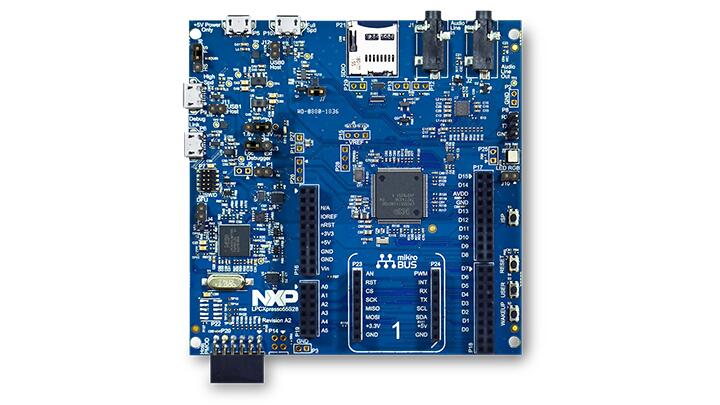NXP LPCXpresso55S28
Overview
The LPCXpresso55S28 development board provides the ideal platform for evaluation of and development with the LPC552x/S2x MCU based on the Arm® Cortex®-M33 architecture. The board includes a high-performance onboard debug probe, audio subsystem and accelerometer, with several options for adding off-the-shelf add-on boards for networking, sensors, displays, and other interfaces.

Hardware
LPC55S28 Arm® Cortex®-M33 microcontroller running at up to 150 MHz
512 KB flash and 256 KB SRAM on-chip
Onboard, high-speed USB, Link2 debug probe with CMSIS-DAP and SEGGER J-Link protocol options
UART and SPI port bridging from LPC55S28 target to USB via the onboard debug probe
Hardware support for external debug probe
3 x user LEDs, plus Reset, ISP (3) and user buttons
Micro SD card slot (4-bit SDIO)
NXP MMA8652FCR1 accelerometer
Stereo audio codec with line in/out
High and full speed USB ports with micro A/B connector for host or device functionality
MikroEletronika Click expansion option
LPCXpresso-V3 expansion option compatible with Arduino UNO
PMod compatible expansion / host connector
For more information about the LPC55S28 SoC and LPCXPresso55S28 board, see:
Supported Features
The lpcxpresso55s28 board configuration supports the hardware features listed below. For additional features not yet supported, please also refer to the NXP LPCXPRESSO55S69 , which is the superset board in NXP’s LPC55xx series. NXP prioritizes enabling the superset board with NXP’s Full Platform Support for Zephyr. Therefore, the lpcxpresso55s69 board may have additional features already supported, which can also be re-used on this lpcxpresso55s28 board:
Interface |
Controller |
Driver/Component |
|---|---|---|
NVIC |
on-chip |
nested vector interrupt controller |
SYSTICK |
on-chip |
systick |
IOCON |
on-chip |
pinmux |
GPIO |
on-chip |
gpio |
I2C |
on-chip |
i2c |
SPI |
on-chip |
spi |
USART |
on-chip |
serial port-polling; serial port-interrupt |
WWDT |
on-chip |
windowed watchdog timer |
ADC |
on-chip |
adc |
CLOCK |
on-chip |
clock_control |
RNG |
on-chip |
entropy; random |
IAP |
on-chip |
flash programming |
Other hardware features are not currently enabled.
The default configuration file
boards/arm/lpcxpresso55s28/lpcxpresso55s28_defconfig
Connections and IOs
The LPC55S28 SoC has IOCON registers, which can be used to configure the functionality of a pin.
Name |
Function |
Usage |
|---|---|---|
PIO0_26 |
SPI |
SPI MOSI |
PIO0_29 |
USART |
USART RX |
PIO0_30 |
USART |
USART TX |
PIO1_1 |
SPI |
SPI SSEL |
PIO1_2 |
SPI |
SPI SCK |
PIO1_3 |
SPI |
SPI MISO |
PIO1_4 |
GPIO |
RED LED |
PIO1_6 |
GPIO |
BLUE_LED |
PIO1_7 |
GPIO |
GREEN LED |
PIO1_20 |
I2C |
I2C SCL |
PIO1_21 |
I2C |
I2C SDA |
System Clock
The LPC55S28 SoC is configured to use the internal FRO at 96MHz as a source for the system clock. Other sources for the system clock are provided in the SOC, depending on your system requirements.
Serial Port
The LPC55S28 SoC has 8 FLEXCOMM interfaces for serial communication. One is configured as USART for the console and the remaining are not used.
Programming and Debugging
Build and flash applications as usual (see Building an Application and Run an Application for more details).
Configuring a Debug Probe
A debug probe is used for both flashing and debugging the board. This board is configured by default to use the LPC-Link2 CMSIS-DAP Onboard Debug Probe.
Configuring a Console
Connect a USB cable from your PC to P6, and use the serial terminal of your choice (minicom, putty, etc.) with the following settings:
Speed: 115200
Data: 8 bits
Parity: None
Stop bits: 1
Flashing
Here is an example for the Hello World application.
# From the root of the zephyr repository
west build -b lpcxpresso55s28 samples/hello_world
west flash
Open a serial terminal, reset the board (press the RESET button), and you should see the following message in the terminal:
***** Booting Zephyr OS v2.4.0 *****
Hello World! lpcxpresso55s28
Debugging
Here is an example for the Hello World application.
# From the root of the zephyr repository
west build -b lpcxpresso55s28 samples/hello_world
west debug
Open a serial terminal, step through the application in your debugger, and you should see the following message in the terminal:
***** Booting Zephyr OS zephyr-v2.4.0 *****
Hello World! lpcxpresso55s28
